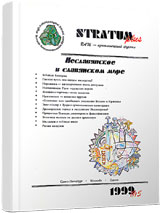«Близнецы» или «двойники»? О сходстве и отличии «волынских» и «прикамских» серег
“Twins” or “Tweedledum and Tweedledee”? On Similarities and Differences Between “Wolyn’” and “Kama” Earrings
Author(s): Svetlana S. RyabtsevaSubject(s): History, Archaeology, Visual Arts, Middle Ages, 6th to 12th Centuries
Published by: Издательский дом Stratum, Университет «Высшая антропологическая школа»
Summary/Abstract: The article deals with a comparative analysis of jewelry: earrings and temple rings, which have a large number of analogies in the South-Eastern, Central and Eastern Europe. Due to their external similarities, the scientists sometimes take the earrings of so-called “Wolyn’ type”, spread from the Dnieper region to the Balkans and Middle Danube region, for “Kama” earrings, spread in the Kama and Volga region. The term “earrings of Wolyn’ type” is understood as a totality of morphologically similar ornaments found in the treasures of Dnieper and Wolyn’ regions. Yet each of these types differs by the manufacturing method, origin and area of prevalence. The author distinguished A, B, C and D types. Thus, the basis of A type are earrings with embossed pendants, represented in proto-Bulgarian (middle VII – early VIII century) and the Great Moravia Antiquities (VIII – IX centuries). In IX – XI centuries the earrings with pendants of a similar shape (but mainly cast ones) were spread on Bulgarian territory (version 3A). In Russia and Poland peculiar versions (1A and 2A) of earrings with larger embossed pendants decorated by granules were spread since the middle of X century. “Wolyn’ earrings” of B type are derived from the earrings characteristic for Middle Avar period. Analogous ornaments with glass beads replaced by metal ones evolve in IX century. The “Wolyn’ earrings” of B type were spread in the Carpathian and Dnieper region, Bulgaria and Yugoslavia. “Wolyn’ earrings” of C type, which pendant consists of just small balls, also derived from Avar and Great Moravian prototypes, were spread on a vast territory embracing Carpathian-Dniester region, Wolyn’, Dnieper region, Transylvania, Hungary, Poland and Yugoslavia. Analogous are the earrings with rolled strings occupying major part of the pendant. They are distinguished as D type and represented, mainly, on the Serb and Yugoslavian territories. As individual findings they are also met in the treasures in the Dnieper region. Earrings and temple rings spread in Kama and in Volga Bulgaria regions are very similar to the mentioned “earrings of Wolyn’ type”. The author examines peculiarities of their morphological structure and manufacturing method in order to distinguish their similarities and differences. Thus, Kama earrings, very similar to the “Wolyn’ earrings” of A type but made using a different manufacturing method, evolved on this territory from VII to XI centuries. They emerged independently of the earrings of “Wolyn’ type” but were also influenced by the Danube models. Grape-like earrings emerge independent of “Wolyn’ earrings” of B and C types and earlier than the latter ones (late VIII-IX centuries) and exist till X century in the Kama region. Yet with all the external similarities, there is a number of differences in the arc of the ring and the grape-like pendant of the Kama earrings, analogous both with late Avar, Caucasus and Saltov jewelry. Thus, “Wolyn’” and “Kama” earrings demonstrate two different jewelry traditions having, however, common origins connected with the jewelry art of Danube and Balkan region based on a compound mixture of nomads’ and settled people’s tastes and Byzantine jewellers’ skills.
Journal: Stratum plus. Археология и культурная антропология
- Issue Year: 1999
- Issue No: 5
- Page Range: 338-356
- Page Count: 19
- Language: Russian

